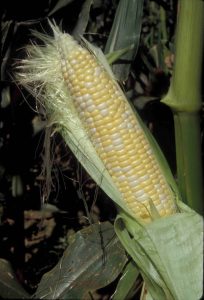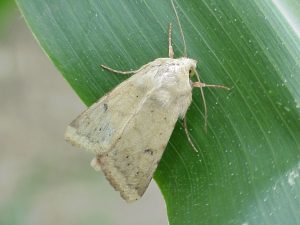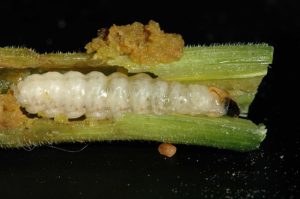Sweet Corn IPM Newsletter No. 4 – August 2, 2019

Sweet Corn IPM Newsletter No. 4 – August 2, 2019
Click on photos to enlarge.
CORN EARWORM THREAT INCREASES
Fall Armyworm, Western Bean Cutworm Pressure Also Higher
SITUATION
Sweet corn growth has been very good with the recent warm weather. Some locations are irrigating as fields have finally dried out from our soggy spring. Pest counts are higher at most locations and silking corn now requires regular protection.
European corn borer: Feeding injury was over the 15% control threshold for pre-tassel corn at only one site in Dayton this week. Moth counts declined at nearly all locations, suggesting that the first generation of corn borer may be past. Only one northern site in Garland was over the spray threshold of 5 moths for silking corn.
Corn earworm: Moth catches increased significantly at some locations, notably at southern and coastal sites. A six-day spray interval for silking corn was recommended in Bowdoinham and Oxford. A five-day spray interval was recommended for silking fields in Dayton and Levant. A 4-day spray schedule was recommended in Auburn, Biddeford, one Cape Elizabeth site, Lewiston, North Berwick, Sabattus, and one Wells site. A 3-day spray interval (our tightest and not commonly required) was recommended at one Cape Elizabeth site.
- Corn Earworm Moth; photo by David Handley
- Male Fall Armyworm Moth; photo by David Handley
Fall armyworm: Moth counts were over the 3-moth threshold for silking corn in Auburn, Cape Elizabeth, Dayton, Lewiston, Nobleboro, Oxford and Poland Spring, but only the Poland Spring site was not already under a spray interval for corn earworm. Larval feeding damage to young corn remains very light, but expect to see damage increase significantly soon.
Squash vine borer: Only one site in Oxford was above the spray threshold of 5 moths this week. However, growers should remain on the lookout for vine borer damage, and protect squash and pumpkins if moths or damage are seen.
- Squash Vine Borer Larva; photo by Jeffrey Hahn, Univ. of Minnesota Extension
- Western Bean Cutworm moth; photo by Lindsey Ridlon
Western bean cutworm: In 2012, we began setting out traps for this insect, which has become a significant pest of corn in the Midwest and Southeast. We have only caught a few moths in the past, but this year, we are finding higher numbers of moths, suggesting that this insect may become another threat to sweet corn in Maine. The larvae of western bean cutworm feed on corn plants and move into the ears through the silk channels or the husks. The threshold for feeding injury on plants is 8%. There isn’t a threshold for moths laying eggs in silking corn yet, but sprays for corn earworm should protect from western bean cutworm as well. The critical time for controlling western bean cutworm is from late pre-tassel to tassel, when the larvae move from the leaves and stalk into the ears. They are more exposed at this time, and are not yet protected within the ears.
Weather information survey for growers
We are seeking input from vegetable growers to help us understand your priorities for weather information to track and predict crop and pest development. You can help with your responses to this quick 8-question online survey. We are also recruiting participants to explore this topic in more detail. Details are at the end of the survey.
Sincerely,
David T. Handley
Vegetable and Small Fruit Specialist
Highmoor Farm UMaine Extension Diagnostic
P.O. Box 179 Research Lab, Pest Mgmt. Unit
52 U.S. Route 202 17 Godfrey Drive
Monmouth, ME 04259 Orono, ME 04473
207.933.2100 1.800.287.0279
Sweet Corn IPM Weekly Scouting Summary
| Location |
CEW |
ECB Moths |
FAW Moths |
%Feeding |
Recommendations / Comments |
|---|---|---|---|---|---|
| Auburn | 9 | 0 | 10 | 0% | 4-day spray interval for all silking corn |
| Biddeford | 45 | 0 | 2 | 3% | 4-day spray interval for silking corn |
| Bowdoinham | 2 | 0 | 0 | 6% | 6-day spray interval for all silking corn |
| Cape Elizabeth I | 34 | 0 | 22 | 0% | 4-day spray interval for silking corn |
| Cape Elizabeth II | 127 | 0 | 2 | 4% | 3-day spray interval for silking corn |
| Charleston | 0 | 0 | 0 | 0% | No spray recommended |
| Garland | 0 | 5 | 0 | 2% | One spray for ECB on silking corn |
| Dayton I | 5 | 0 | 3 | 0% | 5-day spray interval for silking corn |
| Dayton II | 5 | 0 | 12 | 33% | 5-day spray interval for silking corn, ECB on pre-tassel |
| Farmington | 0 | 1 | 0 | 0% | No spray recommended |
| Lewiston | 78 | 0 | 54 | 2% | 4-day spray interval for all silking corn |
| Levant | 6 | 2 | 1 | 1% | 5-day spray interval for all silking corn |
| Nobleboro | 1 | 0 | 3 | 0% | One spray for FAW on silking corn |
| No. Berwick | 9 | 0 | 0 | 2% | 4-day spray interval for all silking corn |
| Oxford | 3 | 0 | 6 | 2% | 6-day spray interval for all silking corn |
| Palmyra | 0 | 1 | 0 | 0% | No spray recommended |
| Poland Spring | 0 | 0 | 9 | 1% | One spray for FAW on silking corn |
| Sabattus | 11 | 1 | 0 | 6% | 4-day spray interval for all silking corn |
| Wayne | 1 | 0 | 0 | 0% | No spray recommended |
| Wells I | 0 | 0 | 0 | 11% | No spray recommended |
| Wells II | 28 | 0 | 0 | 0% | 4-day spray interval for all silking corn |
CEW: Corn earworm (Only fresh silking corn should be sprayed for this insect.)
ECB: European corn borer
FAW: Fall armyworm
Corn Earworm Spray Thresholds for Pheromone Traps
| Moths caught per week | Moths caught per night | Spray interval |
|---|---|---|
| 0.0 to 1.4 | 0.0 to 0.2 | No spray |
| 1.5 to 3.5 | 0.3 to 0.5 | Spray every 6 days |
| 3.6 to 7.0 | 0.6 to 1.0 | Spray every 5 days |
| 7.1 to 91 | 1.1 to 13.0 | Spray every 4 days |
| More than 91 | More than 13 | Spray every 3 days |
Thresholds apply only to corn with exposed fresh silk. Lengthen spray intervals by one day if maximum daily temperature is less than 80°F.
European Corn Borer Thresholds
Whorl stage: 30% or more of plants scouted show injury.
Pre-tassel-silk: 15% or more of plants scouted show injury.
Silk: 5 or more moths caught in pheromone traps in one week.
IPM Web Pages:
UMaine Cooperative Extension Integrated Pest Management
Penn State Pest Watch – Sweet Corn
UMass Amherst Integrated Pest Management
Where brand names or company names are used, it is for the reader’s information. No endorsement is implied nor is any discrimination intended against other products with similar ingredients. Always consult product labels for rates, application instructions and safety precautions. Users of these products assume all associated risks.
The University of Maine is an equal opportunity/affirmative action institution.




